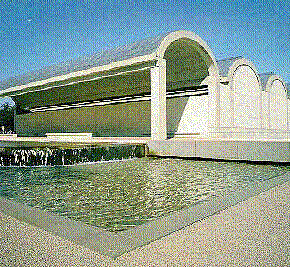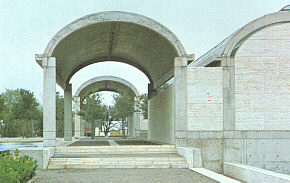| |
Figures of architectural form
Architecture offers a whole typology of counterforms to the 'positions' experienced in this body language. Louis Kahn once said that 'certain forms imply certain functions and certain functions call for certain forms.' It is a reciprocity of just such a kind that binds a world of archetypal forms (aedicule, portico, column, roof) to the close world of appetite, fear and reparation that is enmeshed in the body language. Furthermore, the reciprocity embraces normative rules so that we could say, for example, that the aedicule is the very shape of a certain mode of spatial and psychological perception and to each such level of spatial experience there is such a counterform. It is indicative of the primacy of these counterforms that they preempt all considerations of structure ( the aedicule may be constructed of pisť, or wood or steel or stone) and all discriminations of style (the aedicule is no more Gothic than it is Pompeian or Modern).
The simplest forms architecture ranged at each end of the spectrum that stretches between envelopment and exposure. The primary forms of envelopment are room and roof; both have a clear identity to which specific qualities of 'position' can be assigned. Here we should note that the Modernist concept of the free plan constituted a real challenge to these norms and the determination with which Louis Kahn set out to reassert their autonomy lies at the heart of the most deeply contested shift in architectural experience of the last 20 years.
| |
As it happens, Louis Kahn's Kimbell Art Museum is another prime example of osmotic architecture.
|
| |
Kimbell Art Museum
Fort Worth, Texas, 1967-72
Louis I. Kahn
a modern example of osmotic architecture
And the cloud that passes over gives the room a feeling of association with the person that is in it, knowing that there is life outside of the room, and it reflects the life-giving that a painting does because I think a work of art is a giver of life. So light, this great maker of presences, can never be . . . brought forth by the single moment in light which the electric bulb has. And natural light has all the moods of the time of the day, the seasons of the year, [which] year to year and day for day are different from the day preceding.
Louis I. Kahn, Light is the Theme (Fort Worth: Kimbell Art Foundation, 1975), p. 18.
When Louis Kahn designs a museum, a similar emptying out occurs. These are sacred spaces for supra-earthly contemplation, where light is treated as a mystical presence or supernatural visitor, providing a model of what human users might aspire to. Thus the roof structure becomes and elemant of utmost moment and often remains unsettles and subject to change until late in the process.
This could be read as an allegory--the roof is the building's link with heaven or the membrane between the building and the heavens.
Robert Harbison, Thirteen Ways (Cambridge: The MIT Press, 1997), p. 155.
The scenerio of initiation - death to the profane condidtion, followed by rebirth to the sacred world, the world of the gods - also plays an important role in highly evolved religions. . . .
From one religion to another, from one gnosis or one wisdom to another, the immemorial theme of the second birth is enriched with new values, which sometimes profoundly change the content of the experience. Nevertheless, a common element, an invariable, remains. It could be defined as follows: access to spiritual life always entails death to the profane condition, followed by a new birth.
Mircea Eliade, The Sacred and the Profane - The Nature of Religion (New York: Harcourt, Brace & World, 1959), p. 197 & 201.
Eliade's passage [above] describes perfectly the [Timepiece] transition from metabolism to osmosis, where metabolism = profane and osmosis = sacred and the diaphragm is the transitional partition that delivers the 'second birth'.
Stephen Lauf, Note 241 in Notes to The Timepiece of Humanity (Unpublished, 1994-95).
diaphragm : a body partition of muscles and connective tissues; specifically the partition separating the chest and abdominal cavities in mammals that by its contraction and relaxation varies the relative size and the internal pressure of these cavities and thereby plays an important role in such activities as breathing, defecation, and parturition and that in man has the form of an obliquely placed domed sheet, higher in front than behind, attached to the xiphoid cartilage, the six or seven lower ribs and their cartilage, and the lumbar vertebrae.
parturition : the action or process of giving birth to offspring.
| |



|
In The Timepiece of Humanity--the theory of chronosomatics--the lungs and the physiological operation of osmosis fall within the sacred realm of the body because they are above the diaphragm. It is the diaphragm that not only partitions the profane region of metabolism from the sacred place of osmosis, but it also aids in the transcendence from the profane to the sacred, which according to Eliade involves a 'second birth'. The diaphragm plays an important role in three significant corporal activities: defecation, breathing, and giving birth.
Perhaps there will always be something sacred about an architecture that is truly osmotic.
|
| |
|


